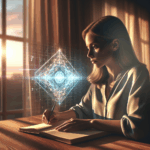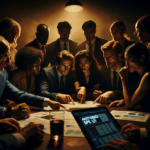Behind the Curtain: Unveiling the Hidden Ingredients of AI Creativity
Artificial Intelligence (AI) has witnessed significant strides over the past decade, elevating its capabilities from mere automation to aesthetic creation. One of the most intriguing aspects of these advancements is AI creativity, particularly within the domain of image generation. Models like DALL·E and Stable Diffusion are pioneering this frontier, capturing the fascination of researchers and technophiles alike. But what gives these systems their creative edge? The answer lies not in perfect algorithmic precision but quite remarkably in their architectural imperfections.
The Mysterious Nature of AI Creativity
What is creativity if not the ability to generate novel and valuable ideas? When applied to artificial intelligence, this notion takes on a new layer of complexity. Rather than suggesting an ability to innovate akin to human artists, the creativity exhibited by AI image generation models may instead stem from the very limitations within their design.
Peeling Back the Layers: The Research
A recent study led by researchers Mason Kamb and Surya Ganguli has delved deep into this phenomenon. Their findings propose that the seeming creativity of AI models is not a deliberate feature but a serendipitous byproduct of the inherent imperfections in the models’ denoising processes. “If they worked perfectly, they should just memorize; But they don’t—they’re actually able to produce new samples,” states Giulio Biroli, illustrating this intriguing paradox (source).
The study carefully dissects the architectural elements, such as locality and equivariance, in diffusion models. These models focus on generating local patches of images independently. The process, akin to solving a puzzle with mismatched but oddly fitting pieces, leads to unexpectedly creative compositions. As Mason Kamb notes, “As soon as you impose locality, [creativity] was automatic; it fell out of the dynamics completely naturally” (source). This insight provides a rich framework to explore not just AI creativity but perhaps human creativity as well.
AI and Morphogenesis: Pathways of Creativity
The creativity unleashed by AI models through mathematical formalism has startling parallels with morphogenesis in biological systems. Morphogenesis, responsible for patterns and structures in biological entities, shares conceptual undertones with the creativity emerging from AI structures. In both realms, complex patterns arise from the recombination and assembly of simple components.
AI Architecture: The Underlying Magic
The architecture of AI models like DALL·E and Stable Diffusion plays a crucial role in their creative output. Instead of perfect emulation, these systems, through architectural constraints, navigate a broad landscape of possibilities. This makes them capable of recombining elements within their training data in ways that appear inventive and spontaneous to human observers.
For instance, imagine an AI model trained on countless images of trees and skies. Instead of generating a precise replica of a single tree or a sky, the model might create an entirely new landscape by blending elements from different images, conjuring an image of a surreal yet captivating forest.
Implications for the Future of Creativity
Bridging Artificial and Human Creativity
These revelations carry profound implications. The borders between human and AI creativity might be thinner than previously thought. As Benjamin Hoover highlights, “Human and AI creativity may not be so different” (source). Both seem to arise from an underlying process of assembling components informed by experiences and environmental cues.
This understanding could revolutionize creative industries. Imagine a world where AI collaborates with human artists not just as a tool but as a partner, bringing its unique, albeit imperfect, creative abilities to the fore. By embracing the imperfections within AI architecture, new forms of art, music, and writing could emerge, each flavored by the distinctive lens of machine-generated artistry.
Future Directions in AI Research
The parallels between AI creativity and biological processes open exciting avenues for future research. By formalizing creativity mathematically, we could gain insights into not only improving AI systems but also understanding cognitive processes within the brain.
Moreover, developments in AI creativity could enhance education and social applications, offering personalized learning experiences or culturally nuanced content generation. As AI continues to evolve, the boundaries of creativity will inevitably expand, reshaping our understanding of originality and innovation.
Conclusion
The journey into the realm of AI creativity reveals a landscape where architectural imperfections paradoxically lead to innovative outputs. Rather than a mere engineering marvel, AI creativity might mirror the processes of the human mind more closely than anticipated. As we continue to explore these frontiers, the possibilities could redefine the essence of creative expression, heralding an era where human and machine creativity intertwine.
Are you ready to dive into the fascinating world of AI creativity? Subscribe to our newsletter and stay updated with the latest insights and discoveries. Join us to explore how AI continues to paint the future canvas of creativity with its unique strokes.
—
By embracing AI as our creative partner, we unlock limitless potential, forging paths where art, science, and technology transcend traditional boundaries. Let’s shape this future together!


